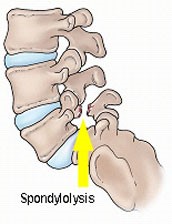If you break the word spondylolysis
down to its Latin roots and then translate to English you get spondylo- which
means “vertebra” and lysis which means “crack or
break”. So spondylolysis is when
there is a crack in the posterior, or back part, of the bony arch of a vertebra
at the pars region (see figure). This
area has a relatively thin area of bone, with a poor blood supply. Hence it has a lower-capacity to heal when it
is stressed. The most concerning
repetitive motion is back hyperextension, with or without rotation. This
typically occurs in the low back (or lumbar spine) in the lowest vertebra (L5
or L4), where there is maximal back motion.
down to its Latin roots and then translate to English you get spondylo- which
means “vertebra” and lysis which means “crack or
break”. So spondylolysis is when
there is a crack in the posterior, or back part, of the bony arch of a vertebra
at the pars region (see figure). This
area has a relatively thin area of bone, with a poor blood supply. Hence it has a lower-capacity to heal when it
is stressed. The most concerning
repetitive motion is back hyperextension, with or without rotation. This
typically occurs in the low back (or lumbar spine) in the lowest vertebra (L5
or L4), where there is maximal back motion.
The cause of this crack is likely
a stress fracture due to repetitive back motion (hyperextension). It is most common in athletes who do
repetitive hyperextension of their back, such as in American football linemen
and gymnasts. Why some individuals get this problem and others don’t is
unknown, but it is likely some individuals have a predisposition to developing
a stress fracture. Interestingly there is a higher frequency of this occurring
in Inuit Eskimos, hence some populations appear more at risk. Evaluation of
this problem starts with plain radiographs but can include CT, MRI, and bone
scans. Treatment is dependent on the previous treatments and how long the
problem has been symptomatic. In general the first level of treatment is
nonsurgical with rest, limitation of activities and bracing (possible). In situations with longstanding pain, a
surgical repair may be the best option. The surgical repair is aimed to simply
getting the crack in the vertebra to heal, without a fusion between vertebra,
so no back motion will be lost. If a spondylolysis occurs in a younger patient,
<12 years of age it is important to get intermittent radiographs of the low
back to watch for any potential slippage of the vertebra forward.
a stress fracture due to repetitive back motion (hyperextension). It is most common in athletes who do
repetitive hyperextension of their back, such as in American football linemen
and gymnasts. Why some individuals get this problem and others don’t is
unknown, but it is likely some individuals have a predisposition to developing
a stress fracture. Interestingly there is a higher frequency of this occurring
in Inuit Eskimos, hence some populations appear more at risk. Evaluation of
this problem starts with plain radiographs but can include CT, MRI, and bone
scans. Treatment is dependent on the previous treatments and how long the
problem has been symptomatic. In general the first level of treatment is
nonsurgical with rest, limitation of activities and bracing (possible). In situations with longstanding pain, a
surgical repair may be the best option. The surgical repair is aimed to simply
getting the crack in the vertebra to heal, without a fusion between vertebra,
so no back motion will be lost. If a spondylolysis occurs in a younger patient,
<12 years of age it is important to get intermittent radiographs of the low
back to watch for any potential slippage of the vertebra forward.
This post has been previously posted in
the Young Athlete Blog
the Young Athlete Blog
Next
blogpost: Why does my back hurt?
blogpost: Why does my back hurt?
